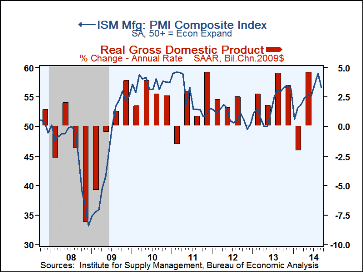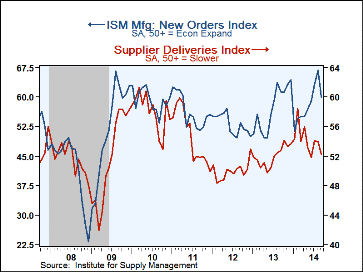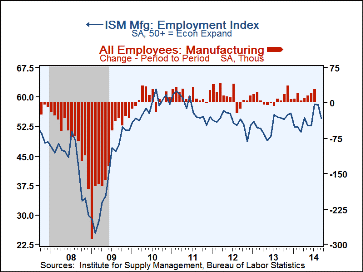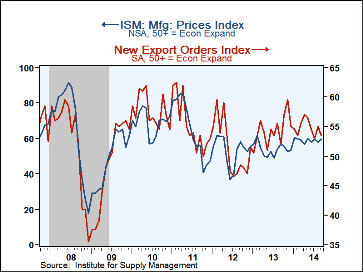 Global| Oct 01 2014
Global| Oct 01 2014U.S. ISM Manufacturing Index Retraces Earlier Increase
by:Tom Moeller
|in:Economy in Brief
Summary
The Institute for Supply Management's composite index of manufacturing sector activity fell back to 56.6 in September after jumping to 59.0 in August. Despite the decline, the Q3'14 average of 57.6 was the highest since Q1'11. The [...]
The Institute for Supply Management's composite index of manufacturing sector activity fell back to 56.6 in September after jumping to 59.0 in August. Despite the decline, the Q3'14 average of 57.6 was the highest since Q1'11. The decline was greater than the forecasted drop to 58.1 in the Action Economics Forecast Survey. Any figure above 50 for this measure indicates increasing manufacturing activity. Over the past decade, there has been a 75% correlation between the level of the ISM manufacturing index and the quarterly percent change in real GDP.
Weakness in last month's composite index was led by a lower new orders reading of 60.0 versus 66.7 in August. Nevertheless, the quarterly average of 63.4 was the highest since Q2'04. The employment index also weakened to 54.6 from 58.1 but the quarterly level of 57.0 showed the strongest hiring in three years. During the last ten years, there has been an 88% correlation between the index and the m/m change in factory sector payrolls. The supplier delivery index fell to 52.2 as the pace of supplier deliveries continued to quicken versus its slowest in February. The production index (64.6) was steady m/m and remained near the highest level of the economic expansion. The inventory series fell m/m to 51.5 but remained in the range in place since 2011.
The prices paid index suggested firm price pressure. Its level of 59.5 was near the average so far this year and was above 53.8 during all of last year. Twenty-eight percent of respondents reported paying higher prices while nine percent paid less. During the last ten years, there has been a 78% correlation between the index and the q/q change in the finished goods producer price index.
The new export orders index fell to nearly its lowest level (53.5) in a year. The order backlog figure (47.0) also was the lowest in just over a year. The imports index weakened to near the lowest level since Q1'13.
The figures from the Institute For Supply Management (ISM) are diffusion indexes and can be found in Haver's USECON database. The expectations number is in the AS1REPNA database.
| ISM Mfg | Sep | Aug | Jul | Sep'13 | 2013 | 2012 | 2011 |
|---|---|---|---|---|---|---|---|
| Composite Index | 56.6 | 59.0 | 57.1 | 56.0 | 53.9 | 51.8 | 55.2 |
| New Orders | 60.0 | 66.7 | 63.4 | 61.3 | 57.2 | 53.1 | 56.4 |
| Production | 64.6 | 64.5 | 61.2 | 61.2 | 57.7 | 53.8 | 57.4 |
| Employment | 54.6 | 58.1 | 58.2 | 54.8 | 53.2 | 53.8 | 57.4 |
| Supplier Deliveries | 52.2 | 53.9 | 54.1 | 52.7 | 51.9 | 50.0 | 54.7 |
| Inventories | 51.5 | 52.0 | 48.5 | 50.0 | 49.4 | 48.2 | 50.1 |
| Prices Paid Index (NSA) | 59.5 | 58.0 | 59.5 | 56.5 | 53.8 | 53.2 | 65.2 |
Tom Moeller
AuthorMore in Author Profile »Prior to joining Haver Analytics in 2000, Mr. Moeller worked as the Economist at Chancellor Capital Management from 1985 to 1999. There, he developed comprehensive economic forecasts and interpreted economic data for equity and fixed income portfolio managers. Also at Chancellor, Mr. Moeller worked as an equity analyst and was responsible for researching and rating companies in the economically sensitive automobile and housing industries for investment in Chancellor’s equity portfolio. Prior to joining Chancellor, Mr. Moeller was an Economist at Citibank from 1979 to 1984. He also analyzed pricing behavior in the metals industry for the Council on Wage and Price Stability in Washington, D.C. In 1999, Mr. Moeller received the award for most accurate forecast from the Forecasters' Club of New York. From 1990 to 1992 he was President of the New York Association for Business Economists. Mr. Moeller earned an M.B.A. in Finance from Fordham University, where he graduated in 1987. He holds a Bachelor of Arts in Economics from George Washington University.










